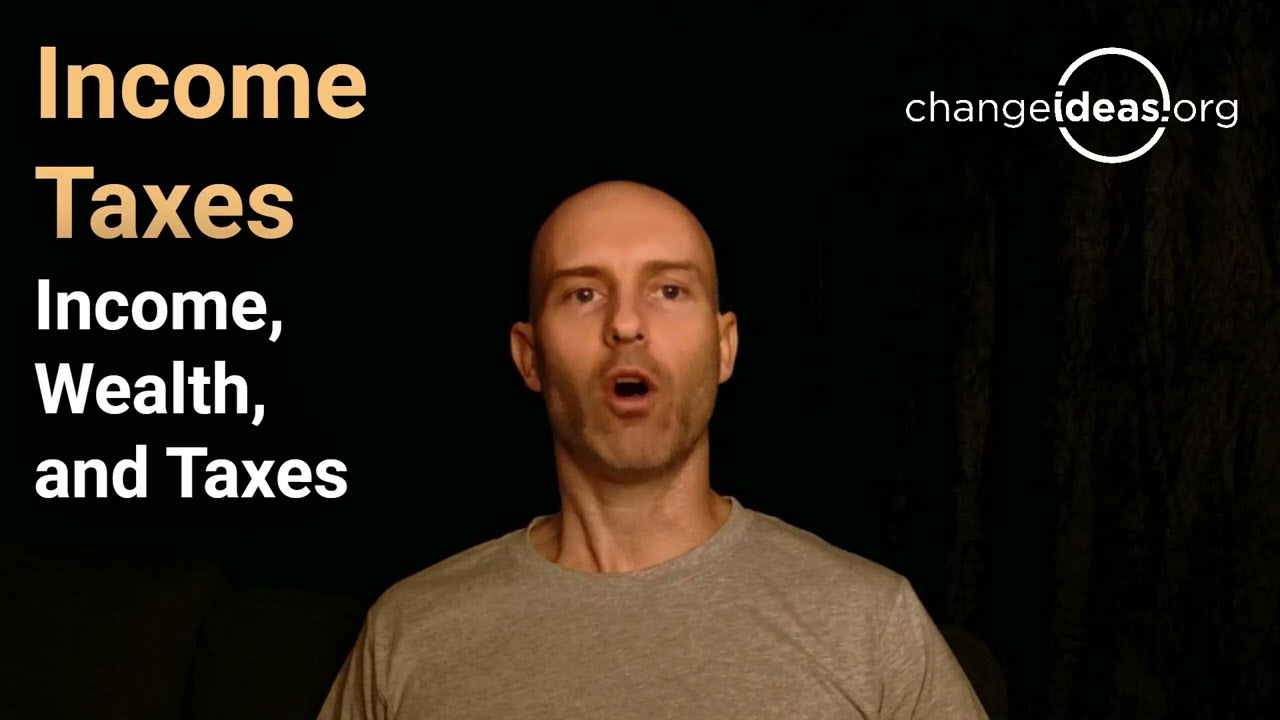All income must be treated equally for tax purposes. This includes earned as
well as unearned income. It includes active and passive incomes. They must all contribute to the
total annual taxable income. Income must be calculated basically
as the total of all wages and gifts, including inheritance,
as well as royalties, dividends. It also includes realized capital
gains and any withdrawn profits. Commissions, bonuses are also included, as
well as allowances, grants, and subsidies. Even people's pensions or
childcare payments Interests and rents, and any loans received,
which we'll get to in a moment. Loans are an interesting one. There must be no categories of income
counted at different tax rates. If a person receives something considered
a liquid asset, then it must contribute to annual income for tax purposes. Illiquid assets, such as unrealized,
capital gains, and real estate, contribute to total wealth calculations, which
is something we will discuss later. Now, on the topic of loans, we want to
have a situation where even personal loans must count towards income,
whereas business loans cannot be used for personal expenses or for
any personal benefit in any way.
For lines of credit, the actual amount
withdrawn or borrowed within each calendar year counts towards taxable income. Including borrowed money closes
a loophole that wealthy people use to avoid paying income tax. The way this works is that because
interest rates are lower than the tax rates that people in upper income
brackets will pay, Paying interest on a personal loan is much cheaper than
paying the upper band of this income tax. So, wealthy people borrow
using their assets as security. And since most assets go up in value,
they can take out additional loans to then pay off their previous loans. This method of tax avoidance
redirects money from public services, benefiting everyone, into private
profit for banks that benefit only their wealthy shareholders. Making personal loans contribute
towards income will stop this practice.
The borrowers that do so will have to
pay the interest, as well as their taxes. This will make the practice more
expensive than simply paying their income taxes like everybody else should. The maximum annual income must be fixed
as a ratio of the minimum annual income. The minimum income must be
calculated based on working full time at the minimum wage. If a country does not have
a minimum income, then it will need to establish one. The only way for the maximum
income to increase must be if the minimum income increases first. This establishes an incentive
for wealthy people to encourage increasing the minimum wage.
Using a 1 to 100 ratio as a
starting example, if the minimum annual income was 15, 000, then the
maximum annual income would be 1. 5 million. However, this ratio is perhaps too
high for maintaining a stable and harmonious society in the long term. Using a smaller ratio of, let's say,
1 to 50, that maximum income of 1. 5 million would translate to a
minimum annual income of 30,000. This is better, but the income
inequality gap will still produce resentment, massive wealth inequality,
and its associated societal problems. So, an ideal ratio for a good society
in the long term might be something around 1 to 10 or 1 to 20 at the most. So let's use a ratio of
1 to 15 as an example. A minimum annual income of 30,000
would mean that the maximum annual income would be 450,000. The aim is to provide a broad range of
incomes between what must be a minimum living wage, that's very important,
and rewarding people for exceptional effort or their exceptional skills.
Society needs to provide an
incentive for people performing hard, dangerous, or even disgusting work. Or if they want to undertake years
of study to gain a qualification and be qualified for a very important
role in society to help others. Or if they want to engage in
entrepreneurial risk, or if they have exceptional knowledge or skills. All of these circumstances are ones in
which individuals need to be rewarded for their contributions to society. Extremely high pay ratios and paying
everyone the same amount are both socially destabilizing options. There needs to be some inequality
or a moderate range between the minimum and maximum income. One benefit of defining the minimum
and maximum income as a ratio is that it removes the need for political
intervention or legislation. The ratio must be established in
the constitution so that wealthy interests cannot capture government
and change a law to benefit themselves. Establishing a fixed ratio
instead motivates the highest earners in society to increase
the incomes of the lowest earners. So they will try to increase
the minimum wage is the idea. And this is because the highest
earners can earn a multiple of those gains for the minimum income.
Using the 1 to 15 ratio, increasing the
minimum annual income by 1,000 means that the maximum income can increase
by 15,000 The actual ratio must be decided democratically after hearing
from independent and interdisciplinary experts informed by empirical research. Whatever the minimum income amount,
it must enable someone with one dependent to earn a basic living
wage, working 80 of full time. This provides at least 20 of the
workday to pursue other interests. For example, people on minimum wage
could choose to use that time to earn more than just a basic living wage. Alternatively, people could use the time
to study or train for a better paying job. They could spend time with
friends and family, or just relax and pursue personal interests. These are the kinds of benefits
that a good society is supposed to provide its citizens. Societies that cannot provide
full time working citizens with a comfortable life beyond merely
surviving are failed societies. Citizens should allow these societies
to collapse so that they can rebuild a better economic system.

Everyone should have the opportunity to
earn enough to have a good life, even those in the lowest paid jobs in society. People should not have to work to
exhaustion and burnout just to exist. A minimum full time income must
provide for a life worth living. Income tax rates must be linked to
the minimum and maximum income levels. The minimum income must automatically
rise and fall with inflation and deflation if that happens.
When the minimum income changes, then
the currency amount defining each bracket must change automatically. Changing tax brackets must not
depend on political decision making. If tax brackets are defined as
fixed currency amounts and do not change automatically, then a greater
proportion of income is pushed into higher tax brackets over time. Inflation erodes purchasing power,
so real incomes do not increase. The combination of inflation and
static income tax brackets means that higher effective tax rates will
be paid each year and people will experience lower standard of living. The tax brackets, therefore,
must automatically adjust. Tax brackets must be also more
granular than they are now, so that the rates increase gradually,
without big jumps in percentages. For example, there could be 101 income tax
brackets with the lowest bracket set at 0%, and each bracket would then increase
by 1% for the remaining 100 brackets.
The marginal rate for each bracket
will only apply to the income that falls within that bracket, as happens
with current progressive tax systems. Any income then over the maximum
level would be taxed at 100%. However, this top tax bracket
would apply to very few people. The aim of having so many tax brackets
is to remove disincentives for jumping into higher tax brackets. In current systems, people jumping the
large thresholds into the next tax bracket may not see as much benefit for their
pay rises if it means suddenly paying a lot of additional taxes on that pay rise. However, with more granular increases,
this problem decreases because pay rises are only gradually taxed more. A prior example uses an income ratio of
1 to 15 with a minimum annual income of 30,000 and a maximum income of 450,000. We can evaluate what 101 tax brackets
would look like with this example. Most tax brackets would span 4,242. This is calculated as the
difference between the maximum and minimum incomes divided by 99. Why 99? The difference is divided by 99
because the bottom bracket is 0 for everything below the minimum income.
And the top bracket of 100% applies
to income above the maximum. So the 101 brackets minus the top and
bottom brackets equals 99 brackets. And this is what we, we divide the
income difference between the maximum and minimum incomes, and that gives us 4,242. All income within the first tax
bracket, so everything below 30,000, attracts a 0% tax rate. Nobody pays any tax on this
first amount of their income. Someone earning 34,242, so
that's the 30,000 plus the first bracket amount, would be taxed
1% on that amount above 30,000.
So they would pay 42 in annual
taxes, Someone with an annual income of 38,484 would pay this
amount plus 2% on their next 4,242. So their total taxable income, or their
total amount payable would be 127. Each additional 4,242, earned
is taxed at an additional 1%. But the higher percentages
only apply to income that falls in each successive bracket. Someone earning the maximum of 450,000
would pay 99 percent on their last bracket of 4,242 and anything over
450,000 would be taxed at 100%, so that establishes the cap of 450,000
or whatever currency you're using. The effective or cumulative
tax rate of someone earning 450,000 would be about 47%. This means a maximum after
tax take home pay of 237,879. This is based on the example of
a 1 to 15 income ratio with a minimum full time income of 30,000. Changing a ratio or the minimum income
changes all the other calculations, so this was just an example.

